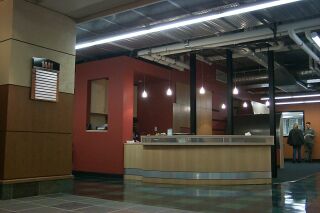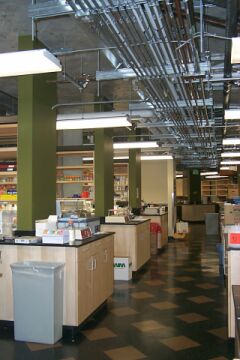January 30, 2002
Lake Union rehab breaks the mold for lab space
Journal Staff Reporter
A working knowledge of biochemistry has served Ken Kornberg well. His Menlo Park, Calif., firm, Kornberg Associates, has designed more than 300 research labs in the U.S. and Europe.

Photos by Sam Bennett With views into computer and robot rooms, the lobby of 1441 Lake Union Center creates a window into the type of work done at the Institute for Systems Biology. |
"It's helpful to understand what they do in their spaces, to make the spaces more suited for the type of work they do," he said. Kornberg studied chemistry in high school, and apparently has science in his genes: his father is a 1959 Nobel laureate in DNA research, his mother a biochemist and both brothers are scientists.
Kornberg Associates designed the interior remodel of the Institute for Systems Biology in 1441 Lake Union Center, on North 34th Street, near Gas Works Park. The 64,000-square-foot facility was designed by Lance Mueller and Associates as an office building and completed in late 2000. The Institute for Systems Biology had it remodeled last year to accommodate 170 biologists, immunologists, computer scientists, mathematicians, engineers and physicists.
|
Kornberg's central challenge was to convert a multi-tenant spec building to lab and office space for the quickly growing two-year-old biotech firm.
The building was designed to reflect the industrial look and historic nature of the area, according to project architect Jerry Fleet, who worked with Mueller on the design. "The classic nature of bricks give reference to those warehouse elements in the area," said Fleet. Tubular steel is used in anchoring the canopy over the front entrance, reinforcing the industrial look.
Mueller designed the building for office space, which presented Kornberg with unusual challenges. For starters, the floor-to-floor height was extremely tight for a lab building, and the ventilation/exhaust systems had to be carefully organized and modified to match the existing shafts and vertical penetrations. Hazardous materials areas had to be isolated, and exhaust systems modified to handle 10 times the air volume of a typical office structure.
The facility also required extensive computer connectivity, and systems to accommodate de-ionized water, natural gas and nitrogen.
For the interior re-design Kornberg Associates architect Seattle Investment Partners LLC developer BN Builders general contractor Encompass mechanical engineer TKG Engineering electrical engineer Engineers Northwest structural engineer |
To express the technology, the design calls for a high level of transparency -- even in the lobby, where visitors can view DNA samplers and robotic arms. The theme continues into workspaces, which are designed to be extremely flexible so that staff and scientists can shift teams quickly and efficiently. Differentiating the workspaces of chemists or biologists, for example, hurts their ability to collaborate.
"This open design breaks the traditional mold and is how more and more labs will look in the 21st century," said Kornberg. "Flexibility is so critical in research. Eliminating walls enables scientists to work side-by-side, contributing complementary skills and knowledge to the institute's research. At a single lab bench at the institute, you'll find specialists who in many research environments would find themselves not just in different rooms but different buildings."
Alan Aderem, associate director of the institute, characterized the design as a completely interactive environment for many different disciplines. "Every person was involved in giving input to designing the space," he said. "What we have is input from all levels."
What the institute had before was a "rabbit warren," Aderem said.
Its former headquarters on Roosevelt Way Northeast was half the size of the new facility and lacked the open floor plan that now fosters collaboration across scientific disciplines. The lines between disciplines don't have much meaning anymore, particularly as organizations like the Institute for Systems Biology integrate computational functions, Kornberg said.

Laboratories in the institute reveal duct work and foster side-by-side work of scientists in complementary fields. |
Systems biology is an emerging discipline that takes a global look at complex biological functions. The institute is dedicated to an approach that requires the integration of science, technology and bioinformatics.
The institute was founded by Leroy Hood, Ruedi Aebersold and Alan Aderem as a public research institute. Hood, who co-developed the automated genetic sequencing technology that enabled the Human Genome Project, was among a small group of scientists who first advocated for the international effort in 1985. Aebersold is widely recognized for his work in analytical protein biochemistry and proteomics.
"The systems approach to biology has dramatic potential for targeting diseases like cancers and AIDS that are now essentially incurable, and multidisciplinary collaboration is at the heart of succeeding," said Hood, the institute's director and president. "We designed the new facility to reinforce this core tenet of the institute, creating an environment that supports collaboration and embodies what we're all about."
Kornberg said his designs, even for academia, emphasize the integration of many disciplines. "It's happening everywhere," he said.
Kornberg Associates has designed for private research institutions and universities including Bristol-Myers Squibb, Eli Lilly, the California Institute of Technology, Stanford University, Université Louis Pasteur, the University of Texas and University of California branches at Davis, Irvine, San Diego and San Francisco.
Aside from breaking down barriers between disciplines, the Lake Union site rewards lab workers by giving them the best views of downtown Seattle. "That was democracy," Kornberg reasoned. "We wanted to get that view to as many as we could."

The 1441 Lake Union Center takes its industrial design cues from nearby buildings. |

Designed by Lance Mueller and Associates, the project was built as an office spec building. Last year the institute chose it as its new 64,000-square-foot headquarters. |
